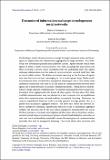Dynamics of information exchange in endogenous social networks
Author(s)
Acemoglu, Daron; Bimpikis, Kostas; Ozdaglar, Asuman E.
DownloadAcemoglu-2014-Dynamics of informat.pdf (591.1Kb)
PUBLISHER_CC
Publisher with Creative Commons License
Creative Commons Attribution
Terms of use
Metadata
Show full item recordAbstract
We develop a model of information exchange through communication and investigate its implications for information aggregation in large societies. An underlying state determines payoffs from different actions. Agents decide which other agents to form a costly communication link with, incurring the associated cost. After receiving a private signal correlated with the underlying state, the agents exchange information over the induced communication network until they take an (irreversible) action. We define asymptotic learning as the fraction of agents who take the correct action, converging to 1 as a society grows large. Under truthful communication, we show that asymptotic learning occurs if (and under some additional conditions, also only if) in the induced communication network most agents are a short distance away from “information hubs,” which receive and distribute a large amount of information. Asymptotic learning therefore requires information to be aggregated in the hands of a few agents. We also show that while truthful communication may not always be a best response, it is an equilibrium when the communication network induces asymptotic learning. Moreover, we contrast equilibrium behavior with a socially optimal strategy profile, that is, a profile that maximizes aggregate welfare. We show that when the network induces asymptotic learning, equilibrium behavior leads to maximum aggregate welfare, but this may not be the case when asymptotic learning does not occur. We then provide a systematic investigation of what types of cost structures and associated social cliques (consisting of groups of individuals linked to each other at zero cost, such as friendship networks) ensure the emergence of communication networks that lead to asymptotic learning. Our result shows that societies with too many and sufficiently large social cliques do not induce asymptotic learning, because each social clique has sufficient information by itself, making communication with others relatively unattractive. Asymptotic learning results either if social cliques are not too large, in which case communication across cliques is encouraged, or if there exist very large cliques that act as information hubs.
Date issued
2014-01Department
Massachusetts Institute of Technology. Department of Economics; Massachusetts Institute of Technology. Department of Electrical Engineering and Computer ScienceJournal
Theoretical Economics
Publisher
The Econometric Society
Citation
Acemoglu, Daron, Kostas Bimpikis, and Asuman Ozdaglar. “Dynamics of Information Exchange in Endogenous Social Networks.” Theoretical Economics 9, no. 1 (January 2014): 41–97.
Version: Final published version
ISSN
19336837
1555-7561